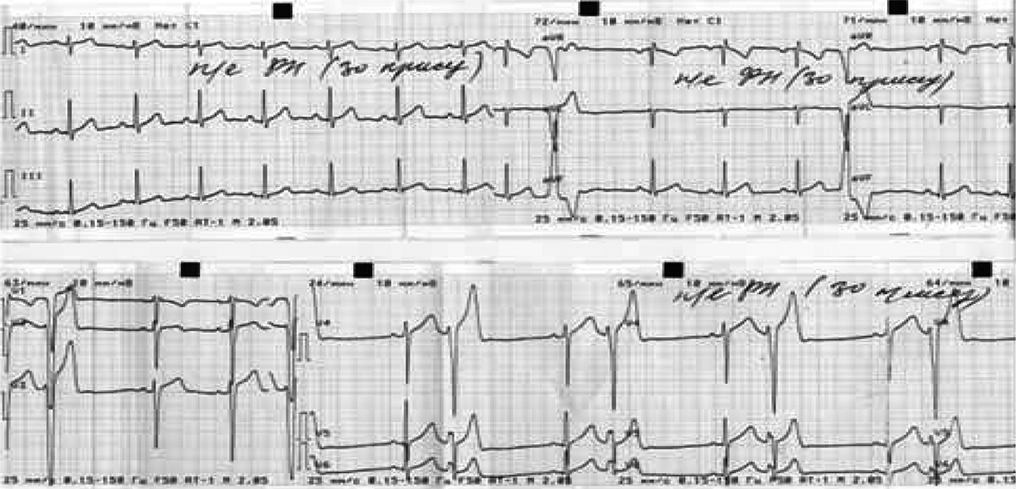Prevention of sudden death in elite athletes in Republic of Sakha (Yakutia)
Фотографии:
ˑ:
Dr.Med., Professor N.V. Makharova 1
Ph.D. I.A. Pinigina2
E.N. Mestnikova2
Ph.D. S.P. Vinokurova1
1 Institute of Physical Culture and Sport of North-Eastern Federal University named after M.K. Ammosov, Yakutsk
2 Center for Sports Medicine and Rehabilitation of State-funded institution of the Republic of Sakha (Yakutia) "Elite sport school", Yakutsk
Keywords: ventricular arrhythmia, screening, sudden death prevention, athletes.
Introduction. Sudden cardiac death (SD) among athletes is still one of the most serious and urgent problems of modern sports medicine. The SD rate in sport may reach 6.5 per 100.000 or even more, which is 2 times higher than that in the population. The overwhelming majority of the deceased athletes were males, and cardiovascular disease was the most common cause of their SD. Coronary disease is the most common cause of SD of athletes over 35 years old. In addition, there is a number of other pathologies causing SD: hypertrophic cardiomyopathy (HCM), arrhythmogenic cardiomyopathy / right ventricular dysplasia (ARVD), congenital coronary artery anomalies, commotio cordis, myocarditis, spontaneous rupture or dissection of the ascending aorta, Wolff-Parkinson-White syndrome, Brugada syndrome, catecholaminergic ventricular tachycardia. The incidence of SD in spor is increasing by 6% year after year [1]. Perhaps, this is due to different climatic and geographical conditions, ethnicity and genetic features.
The purpose of the study was to analyze the monitoring indices of the cardio-vascular system of athletes from the school of elite sportsmanship of SBI RS(Ya) at the premises of the Center for Sports Medicine and Rehabilitation.
Materials and methods. The screening of the cardiovascular system (electrocardiography (ECG), clinical examination) was implemented in the school of elite sportsmanship of the State Budgetary Institution of the Republic of Sakha (Yakutia) as early as in 1990. In 2013, the following methods were introduced: echocardiography (EchoCG), 24-hour Holter ECG monitoring (HMECG), ambulatory blood pressure monitoring (ABPM), bicycle ergometry (BEM). All athletes from the School (n-600) were on a mandatory basis subject to ECG at rest and during physical activity, EchoCG, clinical cardiologist's examination, laboratory tests (complete blood count, common urine analysis, biochemical blood test, blood electrolytes) during an advanced medical examination, stage and ongoing health checks. ABPM, HMECG and BEM were carried out on medical indications.
Results and discussion. During the initial screening, 2650 ECGs were conducted, which revealed that in 27.3% of athletes ECG was unchanged, while in the remaining 72.7% there were particular changes. 600 EchoCGs were carried out, which helped determine minor cardiac abnormalities in 10% of athletes; left ventricular myocardial hypertrophy: by the Society of cardiology of Russian Federation - in 10% of athletes (left ventricular mass index ≥ 125 g/m2), on the criterion of the left ventricular wall thickness ≥ 1.3 cm - in 1 athlete; the echocardiographic picture corresponding to dilated cardiomyopathy was observed in 1 athlete. 26 athletes were subject to ABPM, according to which 3 athletes were diagnosed with the first-degree hypertension. When identifying rhythm disturbances and cardial conduction, all athletes were subject to HMECG. A total of 106 investigations were conductedand revealed: 1 case of ventricular arrhythmia with transient third-degree AV block; 22% - frequent episodes of premature atrial contraction with the second-degree AV block; Mobitz type I block; 5.6% - pronounced sinus arrhythmia of less than 40 beats per minute with wandering pacemaker.
We present the case detection of frequent ventricular arrhythmia. In June, 2014, the athlete S., 26 years old, Master of Sports, visited a doctor complaining about cardiac disruptions, exhaustion after exercises, which appeared in April, 2014, after big competitions. The athlete has been engaged in sports, national jumping, since he was 10 years old. Has been a professional racewalker since he was 22. Master of Sports of the Russian Federation since 2012. Total years in sports - 16. Physical activity totaled about 1400 hours a year. In 2013 -2014, there were 2 starts.
During the screening electrocardiogram we detected sinus bradycardia, 52 beats per minute. The electric axis is in right deviation. There is frequent unifocal monomorphic ventricular arrhythmia by the type of left bundle branch block and an increase in the number of premature beats after exercises (30 squats) (Fig. 1).
The athlete was subject to the 24-hour ECG monitoring, which revealed pronounced bradycardia at night due to the pauses against the background of the second-degree AV - block. We also registered frequent single ventricular arrhythmia by the type of left bundle branch block (right ventricular premature beats), total of 22433 per 24 hours, the maximum amount per hour - 1343, including those by the type of bigeminy - 214, the maximum amount per hour - 61 (10:00), by type trigeminy - 2. It is noted that there is an increase in premature beats against the background of sinus bradycardia. Rhythm disturbance against the background of the second-degree AV - block, transient third-degree AV - block, with pauses, the maximum R-R 2.4 ms, only 10. Transient partial right bundle branch block.

Figure 1
During EchoCG, no minor heart abnormalities were identified. We registered cardiac remodeling in the form of a moderate increase in the end-diastolic dimensions of the left ventricle, right and left atria and left ventricular myocardial hypertrophy on the criterion of the left ventricular mass index.
Postponed diseases: ARVI twice a year, chronic tonsillitis - acute twice a year. Allergic anamnesis: negative. Hereditary anamnesis: negative. Does not smoke. Does not drink. Complete blood count, common urine analysis, biochemical blood test - without pathologies; HIV test, viral hepatitis test, infections test - negative.
No pathologies were detected during the examination of thyroid, kidneys, liver. Electrolytes within the normal values.
Recommended therapy: suspension from exercises and antiarrhythmic treatment (Allopinin). However, after some subjective regression, the athlete was taken "bad", after which the drug was withheld.
Considering the athlete's complaints, data of the objective examination, laboratory and instrumental studies, the athlete was sent to the Federal State Budgetary Institution "State Science Center named after A.I. Burnazyan of the Russia's Federal Medical-Biophysical Agency to prove the diagnosis and decide what further steps to take. Based on the examination, we excluded myocardial genesis of arrhythmia. The athlete was subject to magnetic resonance tomography of the heart (MRT) on October 3, 2014, during which he was diagnosed with local aneurysmatic bulging of the right ventricular wall. It is well known that MRT enables to reveal right ventricular wall thinning and/or significant local disorders of myocardium contractility in the majority of patients (75%) (aneurysmatic bulging - in 42%, dyskinesia - in 33%) [2]. On October 10, 2014, an operation was also carried out - radiofrequency ablation (RFA) of ventricular arrhythmia in the anteroseptal areas of the right ventricular outflow tract. The catheter RFA is one of the interventional methods that effectively eliminate or modify the substrate of one of the main risk factors, namely, ventricular tachycardia and/or atrial fibrillation. The patient was dismissed with a gain in health and recommendations. At this time, he feels fine, has no complaints. The ECG and HMECG did not reveal any disorders. However, taking into account 1 large and 2 small diagnostic criteria of ARVD, this diagnosis is possible [3]. According to the current medical recommendations, for the purpose of disease prevention, he daily takes 1 gram ω3-PUFAs. Molecular genetic testing is in plan view.
It is known that ARVD is associated with a high incidence of ventricular arrhythmias and, above all, with life-threatening ventricular arrhythmias. The autopsy and histomorphologic studies related to sudden cardiac death among young people in St. Petersburg reveal that ARVD is a frequent (14.1%) cause of sudden death. Moreover, the incidence of ARVD is slightly higher compared to a number of the American, European and Indian studies [3, 4, 5, 7], but lower compared to a series of the Italian publications [6]. For patients at risk it is medically necessary to implant cardioverter-defibrillators [8].
Conclusions. The screening of the cardiovascular system of athletes from the school of elite sportsmanship of the Republic of Sakha (Yakutia) enables to identify the risk factors in the sudden death prevention.
References
- Bokeriya, O.L., Vnezapnaya serdechnaya smert' u sportsmenov (Sudden cardiac death in athletes) / O.L. Bokeriya, A.Yu. Ispiryan // Annaly aritmologii. – 2013. – V. 10 . – № 1. – P. 31–39.
- Gavrilova, E.A. Vnezapnaya serdechnaya smert' i gipertrofiya miokarda u sportsmenov (Sudden cardiac death and myocardial hypertrophy in athletes) / E.A. Gavrilova, Ye.V. Zemtsovskiy // Vestnik aritmologii. – 2010. – № 62. – P. 59–62.
- Gordeeva, M.V., Mitrofanova, L.B., Pakhomov, A.V. et al. Aritmogennaya kardiomiopatiya/displaziua pravogo zheludochka kak prichina vnezapnoy serdechnoy smerti molodykh lyudey (Arrhythmogenic cardiomyopathy/ dysplasia of right ventricle as a cause of sudden cardiac death among young people) // Vestnik aritmologii. – 2012. – № 69. – P. 38–40.
- Mitrofanova, L.B. Aritmogennaya kardiomiopatiya pravogo zheludochka i virusnaya infektsiya: vozmozhnye sochetaniya i rol' v geneze zheludochkovykh takhiaritmiy (Arrhythmogenic right ventricular cardiomyopathy and viral infection: possible combinations and role in genesis of ventricular tachyarrhythmias) / L.B. Mitrofanova, O.V. Beshchuk, R.B. Tatarskiy, D.S. Lebedev // Vestnik aritmologii. – 2000. – № 58. – P. 23–30.
- Sedov, V.M. Aritmogennaya displaziya /kardiomiopatiya pravogo zheludochka (Arrhythmogenic dysplasia/ cardiomyopathy of the right ventricle) / V.M. Sedov, S.M. Yashin, Yu.V. Shubik // Vestnik aritmologii. – 2000. – № 20. – P. 23–30.
- Frias, P. Hypertrophic Cardiomyopathy and Arrhythmogenic Right Ventricular Dysplasia in Young Patients // Elsevier. – 2005.– P. 25-31.
- Puranik, R., Chow, C.R., Dufl ou J.A. et al. Sudden death in the young. // Heart Rhythm. – 2005. – Vol. 2. – N 12. – P. 1277-1282.
- Virmani, R., Burke, A.R. and Farb, A. Pathologic experience in USA. In Nava A., Rossi L., editors: Arrhythmogenic right ventricular cardiomyopathy/dysplasia. // Elsevier, Amsterdam. – 1997. – P. 87-93.
- Thiene, G., Nava, A., Corrado, D. et al. Right ventricular cardiomyopathy and sudden death in young people // N. Engl. J. Med. – 1988.– Vol. 318. – P. 129-133. 39. Valente M., Calabrese F., Thiene G. et al.
Corresponding author: makharova@mail.ru



